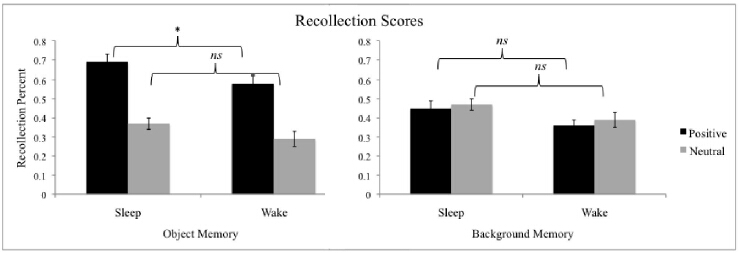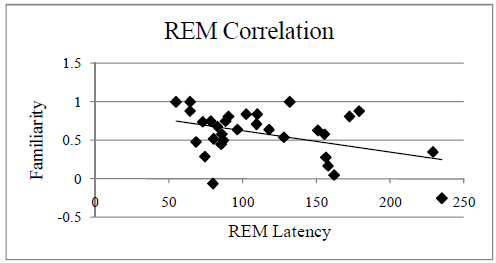Studies have not only shown that a period of sleep following learning offers greater benefits to later memory than a period of wakefulness, but also that sleep actively promotes those components of memories that are emotionally salient. However, sleep's role in emotional memory consolidation has largely been investigated with memories that are specifically negative in content, such as memory for negative images or texts, leaving open the question of whether sleep influences positive memories in a similar manner. The current study investigated the emotional memory trade-off effect for positive versus neutral information. Scenes in which a positive or neutral object was placed on a neutral background were encoded prior to a period of polysomnographically-monitored nocturnal sleep or daytime wakefulness. Recognition memory was tested for the objects and backgrounds separately following the delay using the Remember/Know paradigm. Compared to wake participants, those who slept during the delay had increased recollection memory performance for positive objects, but not the neutral components of the studied scenes. Further, familiarity of positive objects was negatively correlated with REM latency. These results provide preliminary evidence that sleep contributes to the selective processing of positive memories, and point toward a role for REM sleep in positive memory formation.
1.
Introduction
The 3D incompressible resistive Hall-Magnetohydrodynamics system (Hall-MHD in short) is the following system of PDEs for $ (u, p, B) $:
where $ u = (u_{1}, u_{2}, u_{3}) $ is the plasma velocity field, $ p $ is the pressure, and $ B = (B_{1}, B_{2}, B_{3}) $ is the magnetic field. $ \mu $ and $ \nu $ are the viscosity and the resistivity constants, respectively. The Hall-MHD is important in describing many physical phenomena [2,17,19,23,26,27,33]. In particular, the Hall MHD explains magnetic reconnection on the Sun which is very important role in acceleration plasma by converting magnetic energy into bulk kinetic energy.
The Hall-MHD recently has been studied intensively. The Hall-MHD can be derived from either two fluids model or kinetic models in a mathematically rigorous way [1]. Global weak solution, local classical solution, global solution for small data, and decay rates are established in [4,5,6]. There have been many follow-up results of these papers; see [7,8,12,13,14,15,16,18,29,30,31,32,34,35] and references therein.
1.1. The Hall equation with fractional Laplacian
We note that the Hall term $ {\rm{curl}}\left(\left({\rm{curl}} \;B\right)\times B\right) $ is dominant in mathematical analysis of (1) and so we only consider the Hall equations ($ (u, p) = 0 $ in (1)). Also motivated by [7], we consider the Hall equation with fractional Laplacian:
where we take $ \nu = 1 $ for simplicity. (2) is locally well-posed [7] when $ \beta>1 $. But, we do not know whether (2) is locally well-posed when $ \beta = 1 $:
However, we can show the existence of solutions globally in time if initial data is sufficiently small.
Theorem 1.1. Let $ B_{0} \in H^{k} $ with $ k>\frac{5}{2} $ and $ {\rm{div}}\; B_{0} = 0 $. There exists a constant $ \epsilon_{0}>0 $ such that if $ \|B_{0}\|_{H^{k}} \leq \epsilon_{0} $, there exists a unique global-in-time solution of (3) satisfying
Moreover, $ B $ decays in time
where $ C_{0} $ depends on $ \|B_{0}\|_{H^{k}} $ which is expressed in (27) explicitly.
Remark 1. The decay rate (4) is consistent with the decay rates of the linear part of (3).
Remark 2. After this work was completed, the referee pointed out that the same result is proved in [37,Theorem 1.1]. Compared to the proof in [37] where they use the Littlewood-Paley decomposition, we use the standard energy energy estimates and classical commutator estimates.
As one of a minimal modification of (3) to show the existence of unique local in time solutions, we now take a logarithmic correction of (3):
where the Fourier symbol of $ \ln(2+\Lambda)\Lambda $ is $ \ln(2+|\xi|)|\xi| $.
Theorem 1.2. Let $ B_{0} \in H^{k} $ with $ k>\frac{5}{2} $ and $ {\rm{div}}\; B_{0} = 0 $. There exists $ T_\ast = T_{\ast}(\|B_{0}\|_{H^{k}})>0 $ such that there exists a unique local-in-time solution of (5) satisfying
1.2. 2D models
In this paper, we also deal with 2D models closely related to the $ 2\frac{1}{2} $ dimensional (3). If we take $ B $ of the form
we can rewrite (3) as
where $ [f, g] = \nabla f\cdot \nabla^{\perp}g = f_{x}g_{y}-f_{y}g_{x} $. (7) is used to show a finite-time collapse to a current sheet [3,20,21,24] and is used in [10] to study regularity of stationary weak solutions.
1.2.1. Case 1
Although (8) is defined in 2D and has nice cancellation properties (18), the local well-posedness seems unreachable. But, suppose that we redistribute the power of the fractional Laplacians in (8) in such a way that (8b) has the full Laplacian and (8a) is inviscid:
(9) has no direct link to (2), but we may interpret (9) as the $ 2\frac{1}{2} $ dimensional model of the Hall equations where only $ B_{3} $ has the full Laplacian in (2). In this case, we can show that (9) is locally well-posed. Let
Theorem 1.3. There exists $ T_{\ast} = T_{\ast}(\mathcal{E}_{0})>0 $ such that there exists a unique solution of (9) satisfying
Moreover, we have the following blow-up criterion:
Since there is no dissipative effect in the equation of $ \psi $ in (9), we only have the local in tim result in Theorem 1.3. Among the possible conditions for the global existence, we find that adding a damping term to the equation of $ \psi $ works. More precisely, we deal with the following
In this case, we can show the existence of global in time solutions with small initial data having regularity one higher than the regularity in Theorem 1.3. Moreover, we can find decay rates of $ \psi $ by using the structure of equation of $ \psi $ which is a damped transport equation, and this is also the reason why the same method cannot be applied to $ Z $. Let
Theorem 1.4. There exists a constant $ \epsilon_{0}>0 $ such that if $ \mathcal{F}_{0} \leq \epsilon_{0} $, there exists a unique global-in-time solution of (11) satisfying
Moreover, $ \psi $ decays exponentially in time
with $ 1\leq k<5. $
1.2.2. Case 2
As another way to redistribute the derivatives in (8), we also deal with
Let $ \mathcal{E}(t) $ and $ \mathcal{E}_{0} $ be defined as before (10).
Theorem 1.5. There exists $ T_{\ast}>0 $, which is depending on $ \mathcal{E}_{0} $, such that there exists a unique solution of (12) satisfying
Moreover, we have the following blow-up criterion
We now add a damping term to the equation of $ Z $ in (12):
In this case, we can use the same regularity used in Theorem 1.5 because the dissipative effect in $ \psi $ helps to control $ \Delta \psi $ in the equation of $ Z $. Let $ \mathcal{N}_{2}(t) = \left\|\nabla\psi(t)\right\|^{2}_{H^{5}}+\left\|Z(t)\right\|^{2}_{H^{3}} $.
Theorem 1.6. There exists a constant $ \epsilon_{0}>0 $ such that if $ \mathcal{E}_{0} \leq \epsilon_{0} $, there exists a unique global-in-time solution of (13) satisfying
Remark 3. Compared to Theorem 1.3, we only need one term in the blow-up criterion in Theorem 1.5 which is due to the dissipative effect in the equation of $ \psi $. Compared to Theorem 1.4, the proof of Theorem 1.6 is simpler, but we are not able to derive decay rates of $ \psi $ and $ Z $.
2.
Preliminaries
All constants will be denoted by $ C $ and we follow the convention that such constants can vary from expression to expression and even between two occurrences within the same expression. And repeated indices are summed over.
The fractional Laplacian $ \Lambda^{\beta} = (\sqrt{-\Delta})^{\beta} $ has the Fourier transform representation
For $ s>0 $, $ H^{s} $ is a energy space equipped with
In the energy spaces, we have the following interpolations: for $ s_{0}<s<s_{1} $
2.1. Inequalities
We begin with two inequalities in 3D:
We also provide the following inequalities in 2D
which will be used repeatedly in the proof of Theorem 1.3, Theorem 1.4, Theorem 1.5, and Theorem 1.6. We also recall
which holds in any dimension.
We finally provide the Kato-Ponce commutator cstimate [22]
and the fractional Leibniz rule [11]: for $ 1\leq p<\infty $ and $ p_{i}, q_{i} \ne 1 $,
2.2. Commutator
We recall the commutator $ [f, g] = \nabla f\cdot \nabla^{\perp}g = f_{x}g_{y}-f_{y}g_{x} $. Then, the commutator has the following properties:
3.
Proof of Theorem 1.1 and Theorem 1.2
3.1. Proof of Theorem 1.1
We recall (3):
3.1.1. Approximation
We first approximate (19) by putting $ \epsilon \Delta B $ to the right-hand side of (19):
We then mollify (20) as follows
where $ \mathcal{J}_{\epsilon} $ is the standard mollifier described in [25,Chapter 3.2]. Then, as proved in [4,Proposition 3.1], there exists a unique global-in-time solution $ \left\{B^{(\epsilon)}\right\} $ of (21). Since the bounds in Section 3.1.2 are independent of $ \epsilon>0 $, we can pass to the limit in a subsequence and show the existence of smooth solutions globally in time when $ B_{0}\in H^{k} $, $ k>\frac{5}{2} $, is sufficiently small as in [37,Section 3.2].
3.1.2. A priori estimates
We begin with the $ L^{2} $ bound:
We now take $ \Lambda^{k} $ to (19) and take the inner product of the resulting equation with $ \Lambda^{k}B $. Then,
By (16) and (15a) with $ k>\frac{5}{2} $,
So, we obtain
By (22) and (24),
If $ \left\|B_{0}\right\|_{H^{k}} = \epsilon_{0} $ is sufficiently small, we can derive a uniform bound
3.1.3. Uniqueness
Let $ B_{1} $ and $ B_{2} $ be two solutions of (19). Then, $ B = B_{1}-B_{2} $ satisfies
with $ B_{0} = 0 $. We take the inner product of (26) with $ B $. By (17) with $ k>\frac{5}{2} $,
where we use (15b) to control $ L^{6} $ and $ L^{3} $ terms. If $ C\epsilon_{0}<1 $, (25) implies $ B = 0 $ in $ L^{2} $ which gives the uniqueness of a solution.
3.1.4. Decay rates
By (14), it is enough to derive the decay rate with $ k = l $ to show (4). Since
by (14) and (22), we create the following ODE from (24)
By solving this ODE, we find the following decay rate
3.2. Proof of Theorem 1.2
We recall (5):
The the uniqueness part of Theorem 1.2 is the same as that of Theorem 1.1 and we only derive a priori bounds. Let
We begin with the $ L^{2} $ bound:
Following the computations in the proof of Theorem 1.1, we also have
For each $ N\in \mathbb{N} $, we have
So, (29) is replaced by
We now choose $ N>0 $ such that
and so $ N \sim \|B\|_{H^{k}} $. Then, (29) is reduced to
By (28) and (30), we obtain
and so we have
By solving this ODE, we can derive (6).
4.
Proof of Theorem 1.3 and Theorem 1.4
4.1. Proof of Theorem 1.3
We recall (9):
4.1.1. Approximation
We first approximate (31a) by putting $ \epsilon \Delta \psi $ to the right-hand side and mollify the resulting equations as (21). Then, we have
with $ \psi^{(\epsilon)}_{0} = \mathcal{J}_{\epsilon}\psi_{0} $ and $ Z^{(\epsilon)}_{0} = \mathcal{J}_{\epsilon}Z_{0} $. Since (32) is defined in $ \mathbb{R}^{2} $, the proof of the existence of a unique global-in-time solution of (32) is relatively easier than the one to (21). Moreover, the bounds in Section 4.1.2 are independent of $ \epsilon>0 $ and so we can pass to the limit in a subsequence and show the existence of smooth solutions locally in time when $ \psi_{0}\in H^{4} $ and $ Z_{0}\in H^{3} $.
4.1.2. A priori estimates
We first note that
We next multiply (31a) by $ -\Delta \psi $, (31b) by $ Z $, and integrate over $ \mathbb{R}^{2} $. By (18c),
We also multiply (31a) by $ \Delta^{4} \psi $, (31b) by $ -\Delta^{3} Z $ and integrate over $ \mathbb{R}^{2} $. Then,
We now compute the right-hand side of (35). By (18a), (18b), and (18c),
So, we find that the number of derivatives acting on $ (\psi, \psi, Z) $ are $ (4, 4, 2) $, $ (3, 4, 3) $, and $ (4, 2, 4) $ up to multiplicative constants. Hence,
where we use
with $ \delta $ satisfying $ 4C\delta = 1 $. So, we have
By (33), (34), and (37), we derive $ \mathcal{E}' \leq C \mathcal{E}^{2} $ from which we deduce
4.1.3. Uniqueness
Let $ (\psi_{1}, Z_{1}) $ and $ (\psi_{2}, Z_{2}) $ be two solutions of (31) and let $ \psi = \psi_{1}-\psi_{2} $ and $ Z = Z_{1}-Z_{2} $. Then, $ (\psi, Z) $ satisfies the following equations:
with $ \psi(0, x) = Z(0, x) = 0 $. For these equations, we have
The first term is bounded using the definition of $ [f, g] $ and $ {\rm{div}}\; \nabla^{\perp}Z_{1} = 0 $:
We next bound $ \text{(II)+(III)} $ as
The last term is bounded as
So, we have
By (38), $ \left\|\nabla^{2}\psi_{1}\right\|^{2}_{L^{\infty}}+\left\|\nabla^{2}\psi_{2}\right\|^{2}_{L^{\infty}} $ is integrable in time. Integrating (34) and (35) in time, we have
which gives the integrability of the first term in the parentheses on the right-hand side of (39). By repeating the same argument one more time, we have the uniqueness up to $ T_{\ast} $.
4.1.4. Blow-up criterion
Let
We first deal with
and so we have
This implies
We also deal with
As in Section 4.1.3,
We next estimate $ \text{(II)}+\text{(III)} $:
By (41) and (42), we have
which implies
We finally deal with
with the same $ \mathcal{R} $ in (36). So, we have
which gives
By (40) and (43), (44) implies
4.2. Proof of Theorem 1.4
We recall (11):
Since the uniqueness is already proved in Section 4.1.3 even without the damping term, we only focus on the a priori bounds and the decay rates.
4.2.1. A priori estimates
We first have
We now consider the highest order part:
We compute the right-hand side of this. By (18a), (18b), and (18c),
We now count the number of derivatives hitting on $ (Z, \psi, \psi) $ using the integration by parts and (18b) and (18c) up to multiplicative constants. Except for the last integral, we have
The last integral is
and so this gives $ (2, 5, 5) $. So, the combinations of the numbers of derivatives taken on $ (Z, \psi, \psi) $ are
The first and the fourth cases are bounded by
The second case is bounded by
The third case is bounded by
The last one is bounded by
So, we obtain
By (45) and (47),
So, if $ \mathcal{F}_{0} = \epsilon_{0} $ is sufficiently small, we obtain
4.2.2. Decay rates
From (45), $ \left\|\psi(t)\right\|_{L^{2}}\leq \left\|\psi_{0}\right\|_{L^{2}} e^{-t} $. Since
we have
By using (14), we also obtain
5.
Proof of Theorem 1.5 and Theorem 1.6
5.1. Proof of Theorem 1.5
We recall (12):
By applying the same approximation and mollification methods in Section 4.1.1, we can show the existence of smooth solutions locally in time when $ \psi_{0}\in H^{4} $ and $ Z_{0}\in H^{3} $.
5.1.1. A priori estimates
We first have
We next deal with
with the same $ \mathcal{R} $ in (36). In this case, we choose the the number of derivatives acting on $ (\psi, \psi, Z) $ different from Section 4.1.2, which are given by $ (3, 5, 2) $, $ (2, 5, 3) $, and $ (4, 4, 2) $ after several integration by parts. Hence, we have
and so we have the following bound
By (48) and (49), we derive $ \mathcal{E}' \leq C \mathcal{E}^{2} $ from which we deduce
5.1.2. Uniqueness
Let $ (\psi_{1}, Z_{1}) $ and $ (\psi_{2}, Z_{2}) $ be two solutions and let $ \psi = \psi_{1}-\psi_{2} $ and $ Z = Z_{1}-Z_{2} $. As in Section 4.1.3
The first term three terms are bounded as
The last term is bounded as
So, we have
By (50), the terms in the parentheses are integrable up to $ \frac{T_{\ast}}{2} $. By repeating the same argument one more time, we have the uniqueness up to $ T_{\ast} $.
5.1.3. Blow-up criterion
To derive the blow-up criterion, we first bound
and so we have
This implies
We also take
By using the computation in (41),
We next estimate $ \text{(II)}+\text{(III)} $ using (42):
So, we have
By (51), (52) implies
We finally deal with
where we count the number of derivatives acting on $ (\psi, \psi, Z) $ in (46) as $ (3, 5, 2) $, $ (2, 5, 3) $, and $ (4, 4, 2) $. Then, we obtain
and so we have
By (51) and (53), (54) implies
5.2. Proof of Theorem 1.6
We recall (13):
Since the uniqueness is already proved in Section 5.1.2 even without the damping term, we only focus on the a priori bounds.
We first have
We also have
with the same $ \mathcal{R} $ in (36). In this case, we also choose the the number of derivatives acting on $ (\psi, \psi, Z) $ as $ (3, 5, 2) $, $ (2, 5, 3) $, and $ (4, 4, 2) $. Hence,
So, we obtain
By (55) and (56),
So, if $ \mathcal{E}_{0} = \epsilon_{0} $ is sufficiently small, we obtain
Acknowledgments
H.B. was supported by NRF-2018R1D1A1B07049015. H. B. acknowledges the Referee for his/her valuable comments that highly improve the manuscript.
















 DownLoad:
DownLoad: